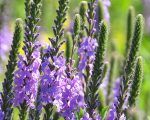 Hoary vervain is a herbaceous perennial and a member of the vervain family, Verbanaceae, that also includes lantanas, verbena, and sandpaper vines. It is native to the Midwest, the Great Plains, and Texas where it grows in meadows, fields, and disturbed sites such as roadsides and railroad right-of ways. Plants grows in clumps two to four feet tall and have branched stems with two to four inch long ovate leaves that are directly attached to the stem and have coarsely toothed margins. Both stems and leaves are covered with white hairs. Small purplish flowers 1/2″ long appear in densely packed terminal panicles from May to September, (primarily in summer) when they bloom a few at a time from the bottom to the top of the panicle. Plants spread by seed and rhizomes and often form colonies by self-seeding. They make valuable garden plants especially in wildlife gardens where they are a larval host and nectar source for butterflies and provide seeds for small birds and mammals. Hoary verbena may become weedy, however, especially in dry poor disturbed soil. The generic name, Verbena, comes from the Latin word verbena meaning leafy branch or twig and refers to the leaves and twigs of some plants used in sacred ceremonies. The specific epithet, stricta, is the Latin word meaning erect.
Hoary vervain is a herbaceous perennial and a member of the vervain family, Verbanaceae, that also includes lantanas, verbena, and sandpaper vines. It is native to the Midwest, the Great Plains, and Texas where it grows in meadows, fields, and disturbed sites such as roadsides and railroad right-of ways. Plants grows in clumps two to four feet tall and have branched stems with two to four inch long ovate leaves that are directly attached to the stem and have coarsely toothed margins. Both stems and leaves are covered with white hairs. Small purplish flowers 1/2″ long appear in densely packed terminal panicles from May to September, (primarily in summer) when they bloom a few at a time from the bottom to the top of the panicle. Plants spread by seed and rhizomes and often form colonies by self-seeding. They make valuable garden plants especially in wildlife gardens where they are a larval host and nectar source for butterflies and provide seeds for small birds and mammals. Hoary verbena may become weedy, however, especially in dry poor disturbed soil. The generic name, Verbena, comes from the Latin word verbena meaning leafy branch or twig and refers to the leaves and twigs of some plants used in sacred ceremonies. The specific epithet, stricta, is the Latin word meaning erect.
Type: Herbaceous perennial
Bloom: Small purplish flowers 1/2″ long in densely packed terminal panicles from May to September (primarily in summer)
Size: 2-4′ H x 1.5-2′ W
Light: Full sun
Soil: Average, dry to medium moist, well-drained
Hardiness: Zones 4-7
Care: Remove if plants become weedy.
Pests and Diseases: None of significance
Propagation: Seed; division in spring
Companion Plants: Butterfly weed, purple coneflower, yellow coneflower